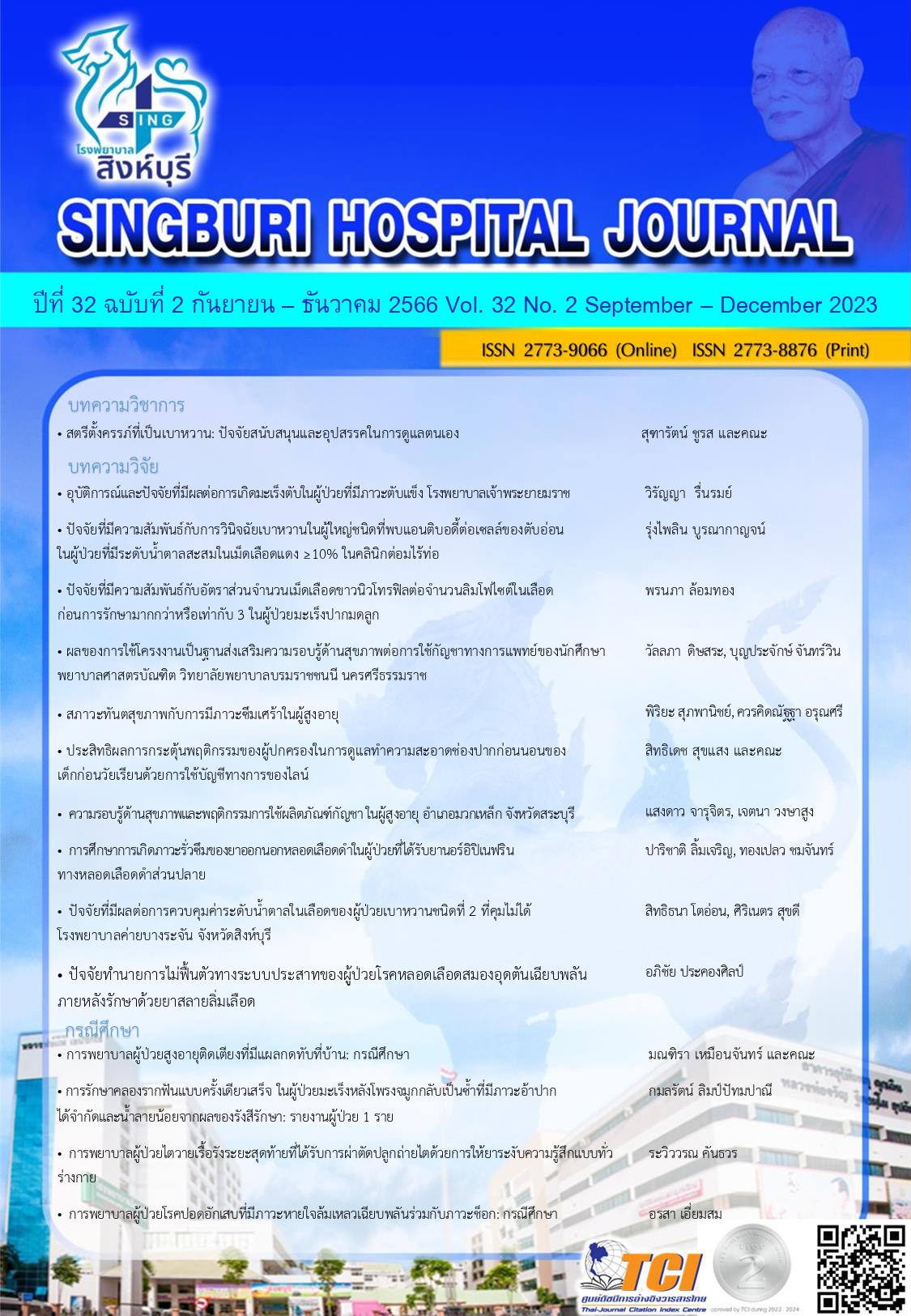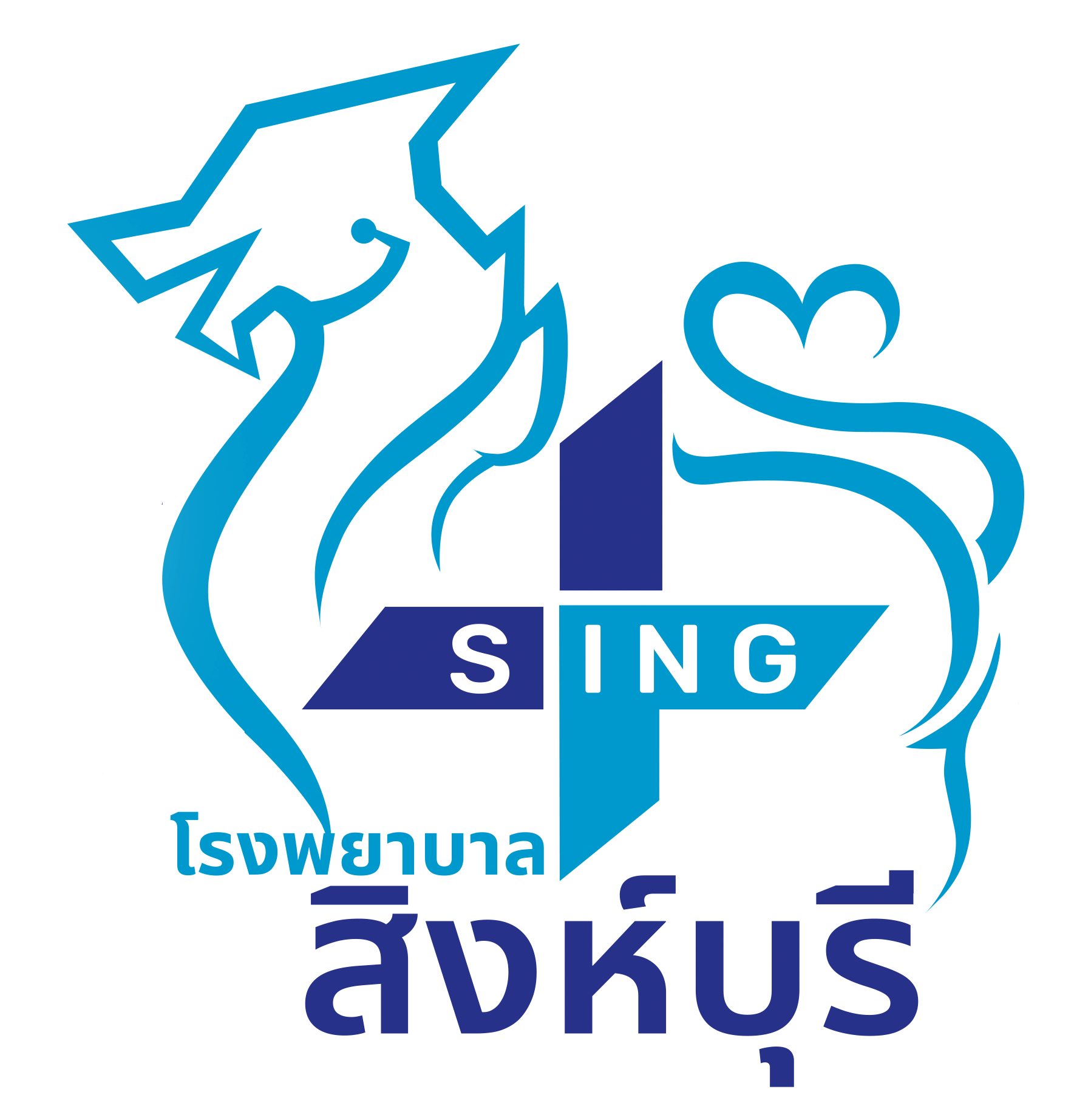ปัจจัยทำนายการไม่ฟื้นตัวทางระบบประสาทของผู้ป่วยโรคหลอดเลือดสมองอุดตันเฉียบพลันภายหลังรักษาด้วยยาสลายลิ่มเลือด
คำสำคัญ:
โรคหลอดเลือดสมองอุดตันเฉียบพลัน, การไม่ฟื้นตัวทางระบบประสาท, ยาสลายลิ่มเลือดบทคัดย่อ
แนวทางการรักษาโรคหลอดเลือดสมองอุดตัดเฉียบพลันคือการให้ยาสลายลิ่มเลือด rtPA ภายใน 4.5 ชั่วโมงนับตั้งแต่มีอาการ ผู้ป่วยบางส่วนกลับไม่มีการฟื้นตัวทางระบบประสาท ผู้วิจัยจึงทำการศึกษาหาปัจจัยที่มีผลต่อการไม่ฟื้นตัวทางระบบประสาท เพื่อเป็นแนวทางในการพัฒนาระบบการรักษา และให้คำแนะนำ โดยใช้การศึกษาแบบย้อนหลัง (retrospective cohort study) จากเวชระเบียนผู้ป่วยที่เป็นโรคหลอดเลือดสมองอุดตันเฉียบพลัน ที่ได้รับยาสลายลิ่มเลือดที่ห้องฉุกเฉินโรงพยาบาลสระบุรี ระหว่าง วันที่ 1 ตุลาคม พ.ศ. 2558 – 30 กันยายน พ.ศ. 2564 ผู้ป่วยในการศึกษา 267 ราย วิเคราะห์ทางสถิติโดยใช้ Chi square หรือ Fisher’s exact test, t-test และmultivariable logistic regression analysis
ปัจจัยที่มีผลต่อการไม่ฟื้นตัวทางระบบประสาท คือ Blood glucose > 110 mg/dL เสี่ยงเพิ่มขึ้น 2.04 เท่า (95%CI 1.04,4.03, p= 0.039) CT Brain พบลักษณะความผิดปกติ ทั้ง small infarction เสี่ยงเพิ่มขึ้น 2.73 เท่า (95%CI 1.53, 6.16, p= 0.010) และ large vessel occlusion เสี่ยงเพิ่มขึ้น 5.34 เท่า (95%CI 2.52, 11.33, p= <0.001)
การพัฒนาระบบการดูแลผู้ป่วยโรคหลอดเลือดสมองอุดตันเฉียบพลัน การอ่านผล CT Brain ให้ถูกต้อง มีความสำคัญต่อกระบวนการพิจารณาให้ยาสลายลิ่มเลือด เช่น หาก CT Brain พบลักษณะ large vessel occlusion อาจพิจารณาทำ mechanical thrombectomy ด้วย และหากผู้ป่วยมีระดับน้ำตาลในเลือดสูงกว่า 110 mg/dL อาจเป็นปัจจัยที่ทำให้การฟื้นตัวทางระบบประสาทไม่ดีนัก
Downloads
เอกสารอ้างอิง
Suwanwela NC. Stroke Epidemiology in Thailand. J Stroke. 2014;16(1):1-7.
Powers WJ, Rabinstein AA, Ackerson T, Adeoye OM, Bambakidis NC, Becker K, et al. 2018 Guidelines for the Early Management of Patients with Acute Ischemic Stroke: A Guideline for Healthcare Professionals from the American Heart Association/American Stroke Association. Stroke. 2018;49:e46–e110.
Hacke W, Donnan G, Fieschi C, Kaste M, von Kummer R, Broderick JP, et al. ATLANTIS Trials Investigators; ECASS Trials Investigators; NINDS rt-PA Study Group Investigators. Association of outcome with early stroke treatment: pooled analysis of ATLANTIS, ECASS, and NINDS rt-PA stroke trials. Lancet. 2004 Mar 6;363(9411):768-774.
Wardlaw JM, Murray V, Berge E, Del Zoppo G, Sandercock P, Lindley RL, et al. Recombinant tissue plasminogen activator for acute ischaemic stroke: an updated systematic review and meta-analysis. Lancet. 2012;379(9834):2364–2372.
Yaghi S, Willey JZ, Cucchiara B, Goldstein JN, Gonzales NR, Khatri P, et al. Treatment and Outcome of Hemorrhagic Transformation After Intravenous Alteplase in Acute Ischemic Stroke: A Scientific Statement for Healthcare Professionals from the American Heart Association/American Stroke Association. Stroke. 2017;48:e343–e361.
Wouters A, Nysten C, Thijs V, Lemmens R. Prediction of outcome in patients with acute ischemic stroke based on initial severity and improvement in the first 24 h. Front Neurol. 2018;9(308):1-6.
Soize S, Fabre G, Gawlitza M, Serre I, Bakchine S, Manceau PF, et al. Can early neurological improvement after mechanical thrombectomy be used as a surrogate for final stroke outcome? J Neurointerv Surg. 201;11(5):450–454.
Agarwal S, Scher E, Lord A, Frontera J, Ishida K, Torres J, et al. Redefined Measure of Early Neurological Improvement Shows Treatment Benefit of Alteplase over Placebo. Stroke. 2020;51(4):1226-1230.
Nam HS, Lee KY, Han SW, Kim SH, Lee JY, Ahn SH, et al. Prediction of long-term outcome by percent improvement after the first day of thrombolytic treatment in stroke patients. J Neurol Sci. 2009;281(1–2):69–73.
Jantasri S, Tiamkao S, Sawanyawisuth K. A 2-point difference of NIHSS as a predictor of acute ischemic stroke outcome at 3 months after thrombolytic therapy. Clin Neurol Neurosurg. 2020;198(106206):1-6.
Sinsoongsud P. Factors Affecting Outcome in Acute Ischemic Stroke Patients with Intravenous Recombinant Tissue Plasminogen Activator (rtPA) Treatment at the Faculty of Medicine Vajira Hospital. Thai journal of neurology. 2021;37(2):1–9.
Wahlgren N, Ahmed N, Eriksson N, Aichner F, Bluhmki E, Dávalos A, et al. Multivariable analysis of outcome predictors and adjustment of main outcome results to baseline data profile in randomized controlled trials: Safe implementation of thrombolysis in Stroke-MOnitoring STudy (SITS-MOST). Stroke. 2008;39(12):3316–3322.
Kent DM, Selker HP, Ruthazer R, Bluhmki E, Hacke W. The stroke-thrombolytic predictive instrument: A predictive instrument for intravenous thrombolysis in acute ischemic stroke. Stroke. 2006;37(12):2957–2962.
Kent TA. Predicting Outcome of IV Thrombolysis–Treated Ischemic Stroke Patients: the Dragon Score. Neurology. 2012;78(17):1368.
Saposnik G, Fang J, Kapral MK, Tu J V., Mamdani M, Austin P, et al. The iScore predicts effectiveness of thrombolytic therapy for acute ischemic stroke. Stroke. 2012;43(5):1315–1322.
ดาวน์โหลด
เผยแพร่แล้ว
รูปแบบการอ้างอิง
ฉบับ
ประเภทบทความ
สัญญาอนุญาต
ลิขสิทธิ์ (c) 2023 โรงพยาบาลสิงห์บุรี

อนุญาตภายใต้เงื่อนไข Creative Commons Attribution-NonCommercial-NoDerivatives 4.0 International License.
บทความที่ได้รับการตีพิมพ์เป็นลิขสิทธิ์ของโรงพยาบาลสิงห์บุรี
ข้อความที่ปรากฏในบทความแต่ละเรื่องในวารสารวิชาการเล่มนี้เป็นความคิดเห็นส่วนตัวของผู้เขียนแต่ละท่านไม่เกี่ยวข้องกับโรงพยาบาลสิงห์บุรี และบุคคลากรท่านอื่นๆในโรงพยาบาลฯ แต่อย่างใด ความรับผิดชอบองค์ประกอบทั้งหมดของบทความแต่ละเรื่องเป็นของผู้เขียนแต่ละท่าน หากมีความผิดพลาดใดๆ ผู้เขียนแต่ละท่านจะรับผิดชอบบทความของตนเองแต่ผู้เดียว







